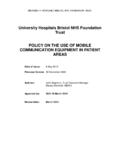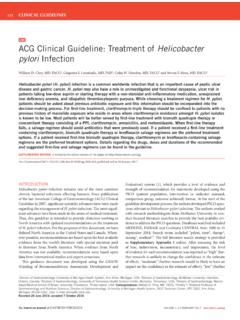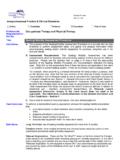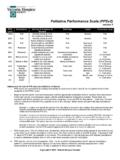Transcription of How To: Set an Audit Sample & Plan Your Data …
1 2009 UHBristol clinical Audit Team Version 3 Page 1 of 11 INTRODUCTION The aim of this How To guide is to provide advice on how to set your Audit Sample and how to design your data collection methodology and your data collection form. Aspects of this guide are discussed in more detail in the following How To guides: 1. How To: Engage Patients, Service Users & Carers in clinical Audit . 2. How To: Apply Ethics to clinical Audit . 1. SAMPLING WHICH CASES SHOULD YOU Audit your Sample population will be dependent upon your Audit topic. Occasionally an aspect of treatment or care that applies to all patients is audited nutrition. However, the majority of clinical Audit tends to focus upon the care of a defined group of patients who share certain characteristics. Typically the fact that they have the same medical condition, have received the same form of treatment or were seen within a certain time frame.
2 For example, patients over 50 years of age admitted to the BRI for a suspected MI. In an ideal world you would Audit the care received by all your Audit population, every patient seen for a given condition over an extended period of time, every treatment received and every outcome achieved, in order to see whether their care met the agreed standards of best practice. However, if the number of patients in this population is too large this becomes impractical and you will need to look at a Sample of your overall population instead. HOW MANY CASES SHOULD YOU Audit For research projects it is very important that a scientifically valid Sample is selected. This is because research is at its most powerful when its results are generalisable to a larger population, nationally or even internationally. For example, a previously unproven surgical method would not be adopted without convincing evidence that it worked otherwise the implications of a change in practice could be catastrophic.
3 clinical Audit , however, simply asks, what is happening here? so the answer does not have to be as definitive as it would need to be in research. The Sample selected for a process-based clinical Audit project should be large enough so that senior clinicians and managers are willing to implement changes based on your findings. It is important to be pragmatic, you are not doing research. In terms of clinical Audit projects a snapshot Sample is usually sufficient, roughly 20-50 cases, for process-based Audit . This will enable you to measure whether processes are being followed as per the standards set. Choosing a larger Sample size than is necessary takes up extra time and resources without adding value, and can mean that there is no time and energy left within your project team to address any issues of below-par practice and bring about improvement. It is also important that your Sample contains current or recent patients.
4 clinical Audit is about improvement; we cannot change the past but you can change the future. For example if your Audit project indicates that the patients seen in the previous month were not given the right drug, changes can be implemented to ensure that future patients are. If, however, your Audit project indicates that patients seen three years ago were not given the right drug, is there anything that we can do about that now? It might be that what constituted best practice three years ago was different. Rarely do you need to look at practice How To: Set an Audit Sample & plan your data Collection 2009 UHBristol clinical Audit Team Version 3 Page 2 of 11 How To: Set an Audit Sample & plan your data Collection more than 12 months ago unless for a specific reason, usually connected with outcomes rather than processes looking at outcomes of a rare procedure.
5 Whilst a snapshot Sample is usually sufficient for process-based Audit , if you need greater assurance in your results, without looking at every patient in your population, you may need to calculate a Sample size that is representative of the whole population. This is likely to be the case if you are auditing outcomes, to be assured that the results you get are within the expected range. CHOOSING Sample SIZES THE SCIENTIFIC APPROACH As mentioned above, occasionally a snapshot Sample will not provide the level of assurance required. This only tends to apply to clinical Audit when outcomes are being assessed. In this instance you may not want to look at every patient in your population, but you may need to calculate a Sample size that is representative of the whole population. Sample size calculations depend on four variables: Size of population. Degree of accuracy required. Degree of confidence required.
6 How often you expect your Audit criteria to be met. The following example shows how this works in practice: A primary care team is planning an Audit of the care of patients with hypertension. There are 300 patients (size of population) being treated for the disorder, but the clinical Audit team do not have time to review the records of them all. The Audit criteria states that patients receiving treatment should have had their blood pressure checked and the result below 150-90 on three occasions in the past 12 months. The target for meeting this standard is set at 70%. However, the team are willing to accept 5% inaccuracy (degree of accuracy) due to sampling. In other words, if the findings give a level of 70%, on 95% of occasions (degree of confidence) the true value would lie between 65% and 75%. The public domain software programme Epi Info ( ) was used by the team to calculate the Sample size using the above parameters, and the Sample required is found to be 155.
7 Strictly speaking, a Sample size calculation should be carried out for each Audit criteria that is being addressed as part of your clinical Audit project. The Sample size chosen for your project should be the largest figure that those calculations produce. The table below appears in a number of guides to choosing Audit Sample sizes and assumes an expected incidence of 50% that standards will be met 50% of the time. It gives the Sample size you will need in order to be 95% sure (degree of confidence) that the results you obtain from the Sample will be within 5% (degree of accuracy) of the results you would have obtained for your whole population if you had collected data on all of them. Put another way, there is a 1 in 20 chance that your results will not be representative. TABLE 1: Sample size Population size Sample size: 95% confidence; +/- 5% 50 44 100 79 150 108 200 132 500 217 1000 278 2000 322 5000 357 2009 UHBristol clinical Audit Team Version 3 Page 3 of 11 How To: Set an Audit Sample & plan your data Collection Using this table, if your Audit showed that Audit criteria X was met in 56% of cases, you could be 95% sure that criteria X would have been met in somewhere between 51-61% of cases had we looked at the whole population.
8 Note that Sample sizes need to be proportionately smaller as the population size increases; looking at 357 out of 5000 patients giving you results with the same degree of certainty as looking at 44 out of a population of 50 patients. This is because the chance of the results being unrepresentative is dramatically reduced as the population size increases. Imagine you tossed a coin five times and got four heads and one tail, that sounds quite reasonable (there could be a pattern emerging, but it's almost certainly just chance that you got four heads). If on the other hand, you tossed a coin 500 times, and got 400 heads to 100 tails, we could be pretty certain that there was something rather dubious about the coin. Remember, Sample sizes can vary according to any one of the following: 1. The expected incidence of the thing you are auditing. 2. The confidence level you want. The confidence level does not have to be 95%.
9 It could be 90%, 99% etc. 3. The level of accuracy you are prepared to accept. The level of accuracy could be 5%, 10%, 1% etc. The table below illustrates how the Sample size might vary for a population of 500: TABLE 2: Sample size Confidence level Degree of accuracy Expected incidence ('best guess') Sample size 95% +/- 5% 50% 217 90% +/- 10% 50% 176 95% +/- 5% 40% 213 95% +/- 5% 20% 165 95% +/- 5% 5% 64 95% +/- 50% 378 95% +/- 5% 185 A Sample size calculator, which takes into account population size, confidence levels, accuracy and expected incidence, is available on the UHBristol clinical Audit website. The website details are listed at the end of this guide. SAMPLING METHODS Once you have decided to take a Sample and have decided on the size of that Sample , the next question is which cases are you going to include in your Audit ? The majority of clinical Audit projects use random sampling or convenience sampling.
10 SIMPLE RANDOM SAMPLING In a simple random Sample every patient within your Audit population has an equal chance of selection. An easy way of selecting your cases is to use a random number table, as per the few lines given below. You could take one number at a time from left to right 2, 0, 1, 7, 4, etc or two at a time, reading down table 20, 74, 04, 22, etc. These cases then form your Sample , the 20th, 74th, 4th, 22nd patients from a list of all the patients in your population. 2 0 1 7 4 2 2 8 2 3 1 7 5 9 6 6 3 8 6 1 0 2 1 0 9 6 1 0 5 1 5 5 9 2 5 2 4 4 2 5 7 4 4 9 0 4 4 9 0 3 0 4 1 0 3 3 5 3 7 0 2 1 5 4 4 7 8 6 9 4 6 0 9 4 4 9 5 7 3 8 0 4 7 0 4 9 3 1 3 8 6 7 2 3 4 2 2 9 6 5 4 0 8 8 7 8 7 1 3 7 1 8 4 7 8 4 0 5 4 7 2 2 4 4 8 9 6 5 6 8 9 5 3 2 5 2 3 8 3 7 1 5 1 2 5 4 0 2 0 1 3 7 5 6 8 7 6 5 8 9 2009 UHBristol clinical Audit Team Version 3 Page 4 of 11 How To: Set an Audit Sample & plan your data Collection Simple random sampling is an example of a probability sampling method.

















